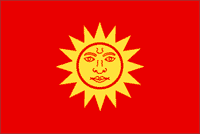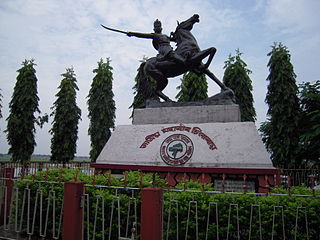| |||||
| Centuries: | |||||
|---|---|---|---|---|---|
| Decades: | |||||
| See also: | List of years in India Timeline of Indian history | ||||
Events from the year 1587 in India.
| |||||
| Centuries: | |||||
|---|---|---|---|---|---|
| Decades: | |||||
| See also: | List of years in India Timeline of Indian history | ||||
Events from the year 1587 in India.
| | This section is empty. You can help by adding to it. (October 2012) |
Narayana is an Indian name. It is identical in form to the name of the deity Narayana, another name for Vishnu. The name Narayana is predominantly used in South India especially among Kannada, Tamil, Malayalam and Telugu speakers.

Bongaigaon district (Prpn:ˈbɒŋgaɪˌgãʊ) is an administrative district in the state of Assam in northeastern India. The district headquarters are located at Bongaigaon. The district occupies an area of 1,093 km2.

Sonitpur district [Pron: ˌsə(ʊ)nɪtˈpʊə or ˌʃə(ʊ)nɪtˈpʊə] is an administrative district in the state of Assam in India. The district headquarters is located at Tezpur.

Cooch Behar district is a district of Indian state of West Bengal.

Cooch Behar, also known as Koch Bihar, was a princely state in India during the British Raj. The state was placed under the Bengal States Agency, part of the Eastern States Agency of the Bengal Presidency. It is located south of the Himalayan kingdom of Bhutan, in present-day West Bengal.

The Koch dynasty ruled parts of eastern Indian subcontinent in present-day Assam and Bengal. Biswa Singha established power in the erstwhile Kamata Kingdom which had emerged from the decaying Kamarupa Kingdom. The dynasty came to power by removing the Baro-Bhuyans, who had earlier removed the short-lived rule established by Alauddin Hussain Shah.

The Kamata Kingdom emerged in western Kamarupa probably when Sandhya, a ruler of Kamarupanagara, moved his capital west to Kamatapur sometime after 1257 CE. Since it originated in the old seat of the Kamarupa kingdom, and since it covered most of the western parts of it, the kingdom is also sometimes called as Kamarupa-Kamata.

Koch Hajo (1581-1616) was the kingdom under Raghudev and his son Parikshit Narayan of the Koch dynasty that stretched from Sankosh river in the west to the Bhareli river in the east on the north bank of the Brahmaputra river. It was created by dividing the Kamata kingdom then under Nara Narayan in medieval Assam. The Sankosh river divided the two new kingdoms, and it is roughly the boundary between the present-day Assam and West Bengal. The western half of the Kamata kingdom emerged as Koch Bihar whereas the eastern half emerged as Koch Hajo. The name Hajo comes from the legendary king Hajo, a Koch tribal chief and an ancestor of the Koch dynasty, who ruled over the Rangpur division in present-day Bangladesh and some regions of present-day Assam.

The Dimasa Kingdom was a late medieval/early modern kingdom in Assam, Northeast India ruled by Dimasa kings. The Dimasa kingdom and others that developed in the wake of the Kamarupa kingdom were examples of new states that emerged from indigenous communities in medieval Assam as a result of socio-political transformations in these communities. The British finally annexed the kingdom: the plains in 1832 and the hills in 1834. This kingdom gave its name to undivided Cachar district of colonial Assam. And after independence the undivided Cachar district was split into three districts in Assam: Dima Hasao district, Cachar district, Hailakandi district. The Ahom Buranjis called this kingdom Timisa.

Sukladhwaja (1510-1577AD), was the 3rd son of Biswa Singha, founder of the Koch Dynasty in the Kamata Kingdom and younger brother of Nara Narayan, the 2nd king of the Koch dynasty of the Kamata kingdom in the 16th century. He was Nara Narayan's commander-in-chief and chief Minister (Dewan) of the kingdom. He got his name Chilarai because, as a general, he executed troop movements that were as fast as a chila (kite/Eagle).
Abhayapuri is a town in Bongaigaon district and 21 km away from Bongaigaon city. It is the headquarters of North Salmara sub-division. It is surrounded by natural forests and hills, and is located on the National Highway 31, about 200 km west of Guwahati. Its nearest airport is at Azara,Guwahati and at Rupsi and nearest railway station is Abhayapuri Railway Station.
Sapatgram is a town and a Municipality Board Area in Dhubri district in the Indian state of Assam.
Naranarayan is a Sanskrit term meaning the combination of the human and the supreme being, here Vishnu. In Sanskrit, nara means human being and narayan means Narayana, another name for Vishnu. In Mahabharata, Arjuna has been identified with nara and Krishna with Narayana.

Naranarayan was the last ruler of the undivided Koch dynasty of the Kamata Kingdom. He succeeded his father, Biswa Singha. Under him the Koch kingdom reached its cultural and political zenith. Under his rule, and under the military command of his brother Chilarai, he was able to subjugate the entire Brahmaputra valley, including the Ahom kingdom; besides the Kachari, Tripura kingdoms, as well as the Khyrem, Jaintia and others. This influence was halted when he faced Suleman Karranni, the Sultan of Bengal.
Events from the year 1540 in India.
The Treaty of Majuli (1563) was settled between the Koch king Nara Narayan and the Ahom king Sukhaamphaa. The treaty followed a successful campaign against the Ahom kingdom led by Chilarai, the general of the Koch forces and the brother of the king, which resulted in the fall of Garhgaon, the Ahom capital. The fall of the capital resulted in the Ahom kings flight, as well as treason by high Ahom officials including the kings own brother. The Ahom king sued for peace via his emissary, Aikhek Burhagohain. During the peace negotiations Nara Narayan was camped at Majuli. The terms that were finally settled on were:
Assamese Brahmins are the Brahmins present in the Assamese society. There they promoted learning, Vedic religion, astrology, ayurveda and as well as imparting general vedic knowledge to the public. The Brahmins came to Assam from Videha (Mithila), Kannauj, Bengal and many other places.
Ananta Manikya was the Maharaja of Tripura from 1563 to 1567. A weak monarch in comparison to his predecessor, he spent his reign under the control of his influential father-in-law. He died after only a few short years of rule, potentially at the latter's hands.

Koch coinage or Coins of Koch dynasty, originally called Narayani Mudra, were issued from 1555 to 1866 under the Koch Kingdom. It was first introduced by the Koch king Nara Narayan in the year of his accession in 1555 A.D or Saka 1477. Both gold and silver coins were impressed. These Narayani coins prevailed over other neighboring kingdoms of Northeast India and North Bengal during this period. Narayani coins were also the medium of trade in some northeastern kingdoms and tribal chiefdoms with Northeast Asia. From 1866, onwards the circulation of Narayani coins was ceased by the British government. However on a few instances after 1866, commemorative coins were impressed for the Raja of Cooch Behar on the day of his ascendancy.